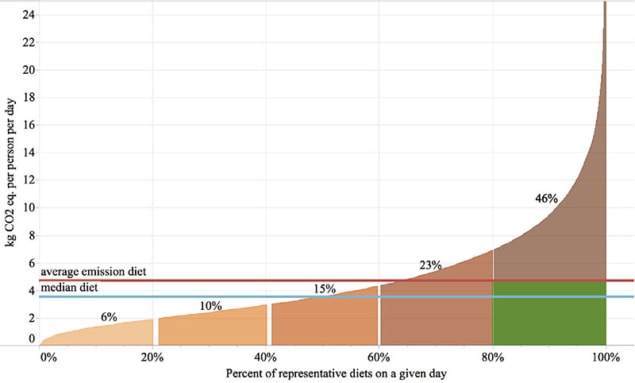
Individual meal choices have a profound effect on our environmental footprint, but much of the analysis has been based on aggregated or stereotyped diets. Now researchers have examined the food choices of more than 16,000 US residents on a single day.
The study shows that an environmental saving equivalent to cutting 661 million passenger vehicle miles could occur if just the top 20% of most intensively emitting meals on a given day were replaced with a diet with the average impact – 4.7 kg of carbon dioxide equivalent.
What’s more, these savings soon add up. The group reported that such a hypothetical diet shift – if implemented every day – could bring the US 9.6% closer to achieving UN Framework Convention on Climate Change targets for 2025.
“One of the key outcomes is being able to represent the greenhouse gas emissions and energy impacts associated with the US diet as a distribution across the population,” said Martin Heller of the University of Michigan.
To examine greenhouse gas emissions and energy use meal by meal, Heller and colleagues linked food life cycle assessment studies to the US National Health and Nutrition Examination Survey (NHANES). Featuring over 16,000 responses, the analysis offers a nationally representative snapshot based on self-selected diets across the country over one day.
The linked database reveals some striking differences in food choices and could help to shape future educational campaigns and policy efforts aimed at encouraging diet shift.
The analysis required pairing over 6000 as-consumed foods and dishes with more than 300 life cycle assessment studies. But the challenges didn’t stop there.
“We had to fill in gaps in the literature by making informed proxy assignments,” said Heller. “However, it turns out these proxies have very little effect on the overall results because they tend to be foods that are consumed in low quantities in the US diet and have relatively low impacts.”
So what advice does the team have so far? “The first recommendation is to pay attention to nutritional needs and avoid excess calories as more food equals more impact,” said Heller. “The second is to be mindful of the consumption of animal-based foods.”
The study highlights that even modest reductions in meat and dairy intake can make a big difference in terms of greenhouse gas emissions saved. Adding to this is the issue of food waste.
“NHANES doesn’t have direct data on food losses, but using other data from USDA that we connected to our databases, we estimated that food losses, at both the retail and consumer level, represent about a quarter of impacts from producing the US diet,” said Diego Rose of Tulane University.
The team’s approach opens the door to assessing how diets contribute jointly to both environmental and health outcomes.
“Establishing a framework for linking the environmental impact of foods to individual diets opens up a whole host of research questions, including further exploration into policy options, economic and social justice considerations,” said Heller.
Future plans include expanding the research to factor in other environmental impacts such as water use and land use.
The team presented the findings in Environmental Research Letters (ERL).



